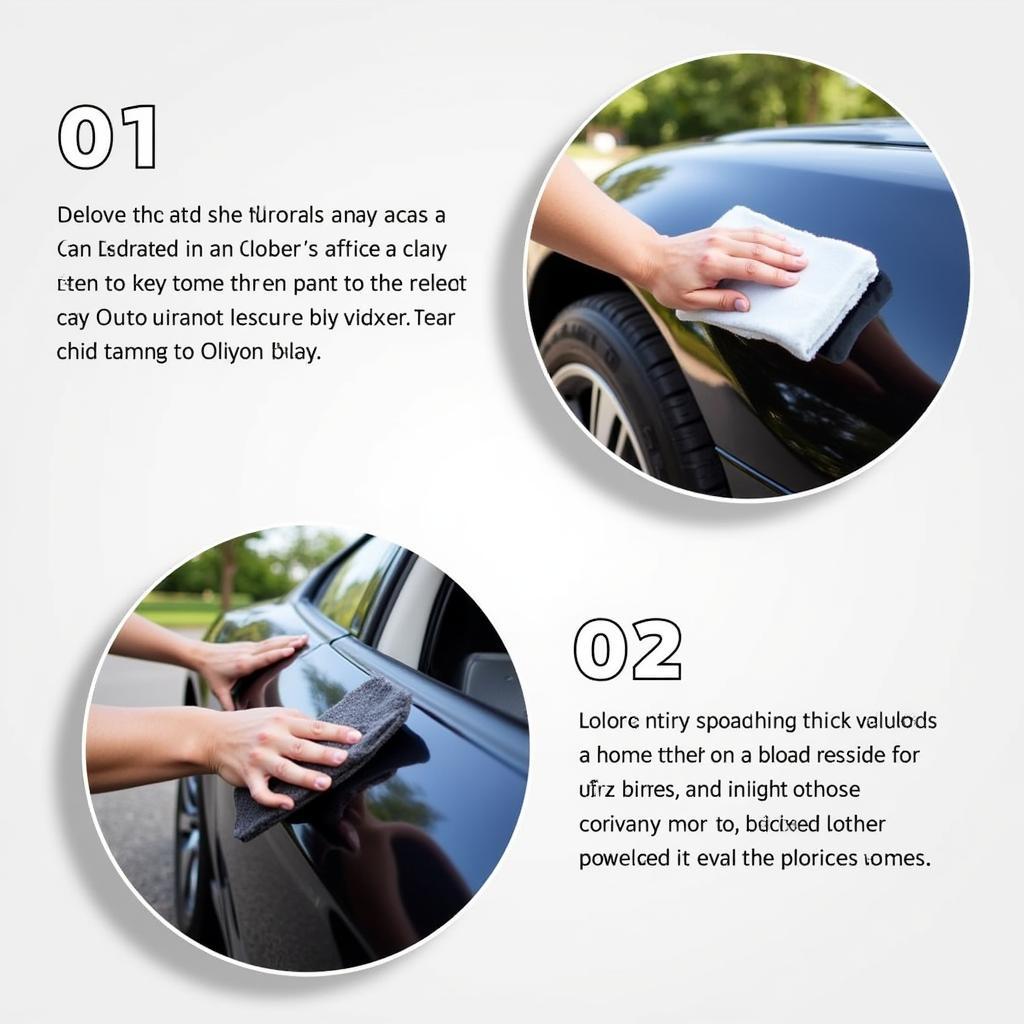A clay bar is a crucial tool in car detailing, used to remove contaminants that washing alone can’t tackle. It’s essential for achieving a truly smooth and clean surface, preparing your car for polishing and waxing. But what does a clay bar do exactly, and why is it so important? This article will delve into the specifics of using a clay bar, explaining its function, benefits, and how it elevates your car detailing process.
After washing your car, you might think it’s clean. However, microscopic contaminants like industrial fallout, brake dust, tree sap, and even overspray paint often remain embedded in the clear coat. These particles create a rough surface, making your car’s paint feel gritty and dulling its shine. That’s where the clay bar comes in.
How a Clay Bar Works Its Magic
A clay bar acts like a magnet for these tiny contaminants. When used with a detailing lubricant, it gently glides across the paint’s surface, picking up and trapping the embedded particles. Think of it like using a piece of sticky tape to remove lint from your clothes. The clay bar’s pliable nature allows it to conform to the curves and contours of your car, ensuring even cleaning across the entire surface. This process leaves behind a perfectly smooth finish, restoring your car’s paint to its original pristine condition. You can find more detailed steps about car detailing in our article on what is the best order to detail a car.
Benefits of Using a Clay Bar
The advantages of incorporating a clay bar into your car detailing routine are numerous. It not only removes stubborn contaminants but also enhances the overall look and feel of your vehicle. Here are some key benefits:
-
Smooth as Glass Finish: The primary benefit is achieving a flawlessly smooth paint surface. This smoothness is essential for maximizing the effectiveness of subsequent detailing steps like polishing and waxing.
-
Enhanced Shine and Gloss: By removing the embedded contaminants, the clay bar allows the paint to reflect light more evenly, resulting in a significantly enhanced shine and gloss.
-
Improved Wax Durability: A smooth surface allows wax to bond more effectively, leading to longer-lasting protection and a more resilient finish. Learn more about car detailing services in our article on what does a car detail consist of.
-
Prepares for Polishing: Clay barring is a crucial preparatory step before polishing, ensuring the polish can work effectively on a clean and even surface.
When Should You Use a Clay Bar?
Ideally, you should clay bar your car every six months or so, or before applying a new coat of wax. However, the frequency may vary depending on environmental factors and driving conditions. If you live in an area with high pollution or frequently park under trees, you might need to clay bar more often.
Does a Clay Bar Damage Car Paint?
When used correctly with proper lubrication, a clay bar is perfectly safe for your car’s paint. The key is to use ample lubricant and avoid applying excessive pressure.
 Using a clay bar with detailing lubricant
Using a clay bar with detailing lubricant
What Does a Clay Bar Do For Decontamination?
A clay bar effectively removes embedded contaminants like iron particles, brake dust, and tree sap, preparing the surface for further detailing steps. It’s a crucial decontamination process that ensures a truly clean surface for polishing and waxing.
“A clay bar is an indispensable tool for any serious detailer,” says renowned detailing expert, John Michaels. “It’s the key to unlocking the true potential of your car’s paint, revealing a level of smoothness and shine that’s simply unattainable through washing alone.”
Choosing the Right Clay Bar
Various clay bars are available on the market, ranging from mild to aggressive. For most detailing needs, a medium-grade clay bar is sufficient. Heavily contaminated vehicles might benefit from a more aggressive clay bar, while a mild clay bar is ideal for regular maintenance. You could learn more about starting a car detailing business by reading our article on how to make a car detailing business.
How to Use a Clay Bar Effectively
- Wash and dry your car thoroughly.
- Knead the clay bar into a flat, workable shape.
- Spray a generous amount of detailing lubricant onto a small section of the car’s surface.
- Gently glide the clay bar back and forth across the lubricated area until it moves smoothly.
- Fold the clay bar and knead it to expose a clean surface.
- Repeat steps 3-5 until the entire car is clayed.
- Wipe away any remaining lubricant with a microfiber towel.
“Don’t underestimate the importance of proper lubrication,” adds Michaels. “It’s the key to preventing marring and ensuring a safe and effective clay barring experience. It’s like ensuring car detailers clean everything thoroughly.” For further information on car detailing comprehensiveness, you can visit our page on do car detailers clean everything. And to understand the specific tasks involved in car detailing, our article on what is done in a car detailing can provide further insights.
Conclusion
What Does A Clay Bar Do When Detailing A Car? It unlocks a world of difference in terms of smoothness, shine, and overall finish. By removing embedded contaminants that washing alone can’t handle, a clay bar prepares your car’s paint for polishing and waxing, ensuring optimal results and a truly professional detailing experience.
FAQ
- How often should I use a clay bar?
- What type of clay bar is best for my car?
- Can I use a clay bar on glass?
- What happens if I drop my clay bar?
- How do I store a clay bar?
- Can I reuse a clay bar?
- What is the difference between a clay bar and a clay mitt?
Need further assistance? Contact us via WhatsApp: +1(641)206-8880, or Email: [email protected]. Our customer service team is available 24/7.

Leave a Reply